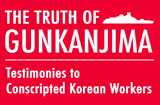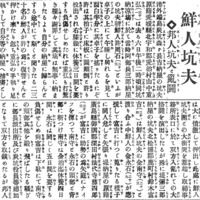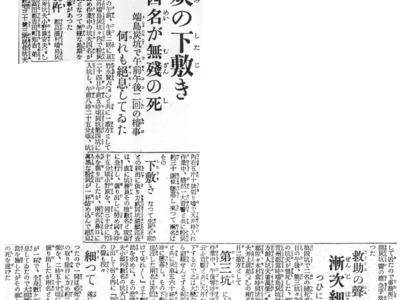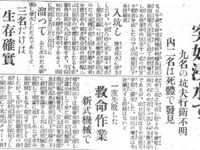News Related to Hashima Before and During the War
One of the ways to research history is to verify newspaper articles. By doing so, we can learn about the realities of Hashima of that time.
We introduce some of the symbolic articles here.
Korean Miners Fight with Japanese Miners July 6th, 1918
A Japanese miner teased a Korean miner while he was taking a nap, accidentally injuring him. The Japanese miner apologized, but the Korean miner returned with a large group of people to retaliate, starting a major brawl. As a result, three Japanese miners were turned in and charged for inflicting injury.
Toyo Hinode Shimbun (Dated July 11th, 1918)
Korean Village Near Nagasaki June 8th, 1922
An article written by a correspondent of Dong-a Ilbo (Korean newspaper) describing the state of Hashima at the time. The article describes in detail the testimonies of Korean workers working in Hashima who say “there are many who will surely return to our homeland once they save several hundreds of yen here”.
Dong-a Ilbo (Dated June 8th, 1922)
Four Die Horrible Death, Crushed by Coal May 24th, 1927
Four miners were killed by a massive collapse of coal dust on May 24th, in two separate incidents, one in the morning and one in the afternoon, at the Hashima Coal Mine.
One of the four dead was a Korean miner.
Nagasaki Nichi Nichi Shimbun (Dated May 27th, 1927)
Sudden Flood - Nine Miners Missing January 5th, 1929
Around 5AM on January 5th, eleven miners went missing while working near the 6th tunnel of Shaft #4, when a flood suddenly inundated the tunnel. Two of the eleven missing were subsequently found dead. The deputy director and other technicians entered the pit to assess the situation and stop the water, but failed. A team of three rescuers used the US-style Proto life saving device to rescue the miners.
Nagasaki Nichi Nichi Shimbun January 6th, 1929
Biggest Gas Explosion on Hashima March 26th, 1935
Biggest Gas Explosion on Hashima. The Nagasaki Nichi Nichi Shimbun issued an extra edition to report the details of the accident. A top executive died in a secondary explosion while attempting to rescue the miners. According to the report, the death toll by this accident reached 27 miners as of the issue of the evening paper on the 30th. 18 of the dead were Japanese, and 9 were Korean. There is no truth that only Korean miners were forced to engage in dangerous work. At the time, the total population of Hashima was 3,200. 1,000 people worked for the coal mine, of which 700 were miners (Nagasaki Nichi Nichi Shimbun).
Extra Edition, Nagasaki Nichi Nichi Shimbun, March 27th, 1935
Details of the large gas explosion disaster at Hashima Coal Mine off Nagasaki Port.
Rescuers descend the 2,000-feet pit of death The fate of the remaining seven lives
Three in critical condition die; others delivered to mining hospital for treatment; Miners hang their heads at pithead in front of “Safety is Number 1 Priority” sign
The bravery and responsibility of the top coal mine executives; Deputy Director Ogawa sacrifices self, in critical condition
Annual Coal Output 250,000 tons; this incident caused the biggest damage yet.
Evening Edition, Nagasaki Nichi Nichi Shimbun, March 28th, 1935
Giant Explosion at Hashima Coal Mine Fire After Loud Explosion Thirty Plus Dead or Injured
Flames burst open sealed wall, erupt furiously
Lives reluctantly sacrificed Fire temporarily extinguished by pumping water in site
Evening Edition, Nagasaki Nichi Nichi Shimbun March 29th, 1935
More details of the massive explosion disaster at Hashima Coal Mine outside Nagasaki port
Death toll reaches 23 Rescued miners dying one by one
Evening Edition, Nagasaki Nichi Nichi Shimbun March 30th, 1935
Survivor down to only one Death toll reaches 27
Promotion of Actions to Fuse Japan-Korea Relationship June 14th, 1935
To promote and improve friendship with Koreans living in Nagasaki, the “Soaikai Nagasaki Headquarters” was inaugurated on June 14th. A grand inaugural ceremony will take place in Sasebo. The organization is expected to implement efforts to harmonize, help, and promote the friendship of Koreans living in Japan.
Nagasaki Nichi Nichi Shimbun June 9th, 1935
10% Pay Raise at Takashima / Hashima Coal Mines July 1st, 1937
Starting July 1st, daily wages at both Takashima and Hashima Coal Mines will be raised by 10%. Company staff who are paid less than 100 yen monthly will also see a pay raise of 10%.
Nagasaki Nichi Nichi Shimbun July 1st, 1937
Twelve Korean Miners at Hashima Arrested for Gambling November 24th, 1938
The Umegasaki Police Station arrested 12 Korean miners who were gambling in the coal mine. According to their confessions, they were playing a popular Korean card game at 10 sens (100th of a yen) per hand. They confessed to playing more than 200 hands. There are testimonies asserting that Korean miners were not paid in Hashima, but this incident verifies that they had in fact been paid salaries.
Nagasaki Nichi Nichi Shimbun November 26th, 1938
Recruiting Good Hanto-jin (Koreans) December 9th, 1939
To promote the harmonization of Koreans living in Japan, and to supplement shortage of labor at the coal mine, a large-scale transfer of Korean workers to Japan was implemented. Beginning in late November, 1,500 young men were brought across the ocean and offered work at the coal mines of Hokushotanden, Sakito, Takashima, and Hashima, via an employment agency.
Nagasaki Nichi Nichi Shimbun December 9th, 1938
Hanto-jin (Peninsular People, meaning Koreans ) Miners Successively Board Boat December 21st, 1939
The strong performance by Korean miners in Hokushotanden caught the eye of the coal mines in Nagasaki Prefecture, which lead to an on-going plan to transfer more to Japan.
Nagasaki Nichi Nichi Shimbun December 21st, 1938
Events to Encourage and Console Hanto (Peninsular, or Korean) Workers October 13th, 1942
The Ainoura Police Station held a sumo tournament and a competition for the Championship flag, sponsored by the Sampo / Kyowakai. By sponsorship of Kyowakai, a charitable group toured the coal mines between November 28th and 29th to perform magic shows and stunt shows, and to show movies, for the education and cultivation of interest and sentiment.
Nagasaki Nichi Nichi Shimbun October 13th, 1942→Article and Photo

















